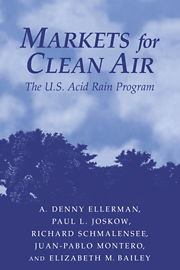Book contents
- Frontmatter
- Contents
- List of Illustrations
- List of Tables
- Preface
- Acknowledgments
- Part I Background
- Part II Compliance and Trading
- 5 Title IV Compliance and Emission Reductions, 1995–97
- 6 Emissions Trading: The Effect on Abatement Behavior
- 7 Emissions Trading: Development of the Allowance Market
- 8 Title IV's Voluntary Compliance Program
- 9 Cost of Compliance with Title IV in Phase I
- Part III Questions and Implications
- Appendix: Effect of Title IV on SO2 Emissions and Heat Input by Susanne M. Schennach
- Bibliography
- Index
8 - Title IV's Voluntary Compliance Program
Published online by Cambridge University Press: 10 December 2009
- Frontmatter
- Contents
- List of Illustrations
- List of Tables
- Preface
- Acknowledgments
- Part I Background
- Part II Compliance and Trading
- 5 Title IV Compliance and Emission Reductions, 1995–97
- 6 Emissions Trading: The Effect on Abatement Behavior
- 7 Emissions Trading: Development of the Allowance Market
- 8 Title IV's Voluntary Compliance Program
- 9 Cost of Compliance with Title IV in Phase I
- Part III Questions and Implications
- Appendix: Effect of Title IV on SO2 Emissions and Heat Input by Susanne M. Schennach
- Bibliography
- Index
Summary
As noted in Chapter 1, Title IV includes a voluntary compliance program intended to enable owners of the 263 Table A units subject to Phase I to make some of the required emission reductions at other units, which then become Phase I-affected units. As we have also noted, the response to this program has been much greater than expected. More than half the electric utilities with Table A units have voluntarily brought units into Phase I in each of its first three years: 182 units in 1995, 161 in 1996, and 153 in 1997. One hundred thirty-eight units – more than half of these units – were subject to Phase I in all three years.
Yet, as encouraging as this response has been, on closer examination it serves to illustrate a general problem with such voluntary provisions. In principle, allowances should be allocated to voluntary units equal to what the emissions of these units would be if they were not part of the program (i.e., counterfactual emissions). If this could be done exactly, participation would be attractive only to units with particularly low abatement costs. In practice, however, allowance allocations generally differ from counterfactual emissions. Units with relatively low control costs that would receive an allocation below their counterfactual emissions are thereby discouraged from participation, while units with relatively high control costs are encouraged to participate by an allocation above their counterfactual emissions.
- Type
- Chapter
- Information
- Markets for Clean AirThe U.S. Acid Rain Program, pp. 197 - 220Publisher: Cambridge University PressPrint publication year: 2000



